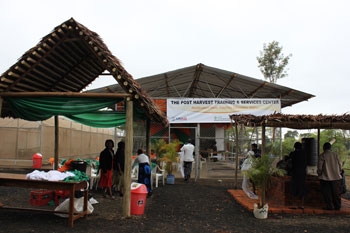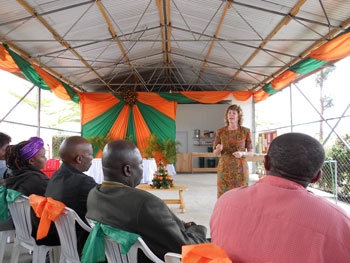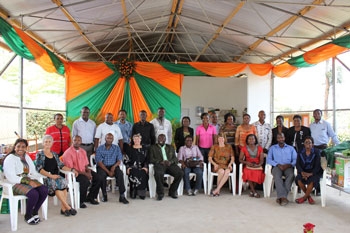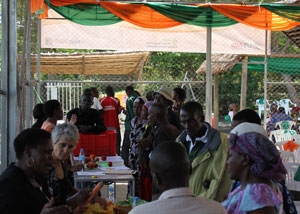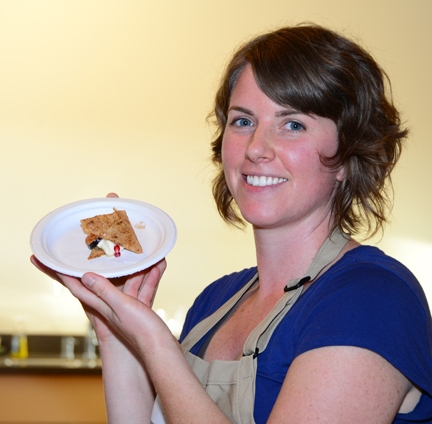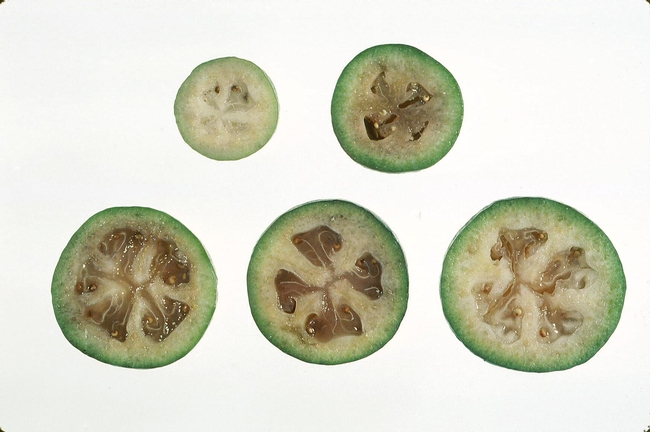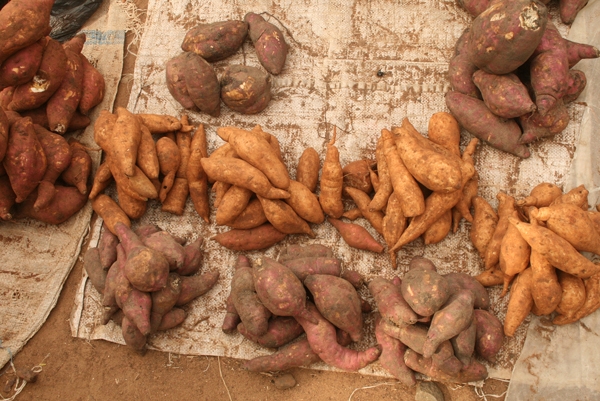UC Food and Agriculture Blogs
A postharvest program in sub-Saharan Africa promises long term benefits
In sub-Saharan Africa, postharvest losses of horticultural crops range from 30 percent to an astonishing 80 percent. Ongoing problems with food quality, safety and nutritional value are well documented. A number of past projects have identified appropriate actions, including implementing improvements in produce handling, training for regional agricultural leaders, capacity building, and small-scale infrastructure development, but these recommendations had not ever been integrated into local solutions. In 2011 the Horticulture CRSP awarded a pilot project to Diane Barrett, UC Cooperative Extension specialist in the Department of Food Science and Technology at UC Davis, Lisa Kitinoja of the World Food Logistics Organization, and Rob Shewfelt of the University of Georgia.
Since receiving funding from Horticulture CRSP, the initial focus has been developing and implementing a year-long, online training of 36 agricultural professionals in advanced postharvest technology, and building the first Postharvest Training and Services Center (PTSC) in Arusha, Tanzania, at the AVRDC – The World Vegetable Center’s Regional Center for Africa Campus.
Then, in early October 2012, when the Arusha PTSC first opened its doors, all 36 of the master trainers traveled to the center to complete the 11-day in-person segment of their training.
By mid-October the 36 “master trainers” officially “launched” the PTSC by participating in a series of training programs for local farmers in Arusha, before returning to their own countries with the designs and tools needed to launch new PTSCs and provide similar services and training. This project and all the PTSCs will provide access to training programs, adaptive research and demonstrations. These, along with the needed tools and supplies, will help to reduce postharvest losses and improve market access and incomes for small holders and women farmers throughout Africa.
“The launch of this pilot Postharvest Training and Services Center in Arusha is a great step in the direction of reducing food losses in developing countries," Kitinoja said.
She continues, "First, since we have trained 36 Africans as postharvest specialists from seven countries in sub-Saharan Africa, we now have a pool of skilled people to help us provide local training programs, demonstrations on improved postharvest practices, small-scale postharvest handling and processing technologies and innovative approaches to postharvest extension work, logistics and management of horticultural value chains. Already these young people have been implementing postharvest training activities in their own countries, and during 2011-12 they were able to reach more than 8,000 extension workers, leader farmers and horticultural entrepreneurs.
“Second, our model PTSC being piloted in Tanzania under the Horticultural CRSP postharvest extension for sub-Saharan Africa will serve as a hub for continuous activities in postharvest research, training of postharvest trainers and extension workers in East Africa, international short courses in postharvest technology, and training of local farmers in cost effective postharvest handling practices. Next week the first meeting will be held for the new Postharvest Working Group for Tanzanian researchers, and for 2013 we already have training programs scheduled on topics including improved practices for harvesting and field packing, cooling and cool storage for perishable crops, improved solar drying and packaging of dried horticultural crops.
“Third, the PTSC will provide local access for local farmers, farmers associations such as TAHA and regional extension workers to the missing postharvest tools, supplies, equipment and services that they will need in order to be able to implement the kind of improvements being promoted via the postharvest training programs being provided in Arusha. Most international projects provide education for potential beneficiaries, but very few projects provide the kind of follow-up that is needed to ensure that those who learn about new practices and technologies will actually get the chance to use them. In this case, a PTSC postharvest shop will allow the beneficiaries to invest in a wide range of options and the postharvest tools and supplies that it requires to be able to use a set of cost-effective improved practices and that leads to practical results and long-term changes, including reduced food losses and improved incomes.”
The Horticulture Collaborative Research Support Program (Horticulture CRSP) builds global partnerships for fruit and vegetable research to improve livelihoods in developing countries. The program is managed by UC Davis (directed by Beth Mitcham who also serves as the Postharvest Technology Center's Director) and funded by USAID. For more information, visit http://hortcrsp.ucdavis.edu.
Pomegranates, figs and honey!
California produces more figs and pomegranates than any other state in the nation; in fact, our state is the sole producer of 99 percent or more of the U.S.-grown pomegranates and figs, according to the California state office of USDA's National Agricultural Statistics Service.
And honey? The Golden State ranks second in honey production, eclipsed only by North Dakota.
So why not combine all of them into a dessert? And add some walnuts and goat cheese for good measure--and good taste?
That’s exactly what Julie Loke of the Davis Food Co-Op did at the debut event of the newly established Honey and Pollination Center of the Robert Mondavi Institute for Wine and Food Science (RMI) at UC Davis.
The event, held Oct. 27 in the RMI’s Silverado Vineyards Sensory Theatre, drew talks on honey and pollination, and showcased a bee observation hive from the Harry H. Laidlaw Jr. Honey Bee Research Facility.
The Honey and Pollination Center, approved earlier this year by the UC Davis College of Agricultural and Environmental Sciences, aims to “make UC Davis the nation’s leading authority on honey, honey bees and pollination by combining the resources and expertise of RMI and the Department of Entomology’s Harry H. Laidlaw Jr. Honey Bee Research Facility,” said RMI executive director Clare Hasler-Lewis.
The center's goals include:
- Expand research and education concerning nutrition, health, quality and appreciation of honey
- Develop useful information for California’s agricultural bounty that depends on insect pollination
- Help the honey industry establish labeling guidelines to guarantee pure and unadulterated varietal honey
- Coordinate a multidisciplinary team of experts in honey production, pollination and bee health
- Promote the use of locally procured honey in the home, food industry and restaurants
Loke, the Davis Co-Op Teaching Kitchen coordinator, says she’s been obsessed with food for as long as she can remember. With 10 years of experience following “foodie adventures” (her repertoire includes running a kitchen on an eco-cruise, working in an organic garden, and teaching kids how to cook from scratch), she now teaches cooking classes at the Davis Co-Op, where she works full-time doing marketing, education and events.
The pomegranate is one of her favorite new foods.
“I’m from the East Coast and Midwest and had very little exposure to them growing up,” she said. “I love the act of breaking open the skin and having the arils (the juicy seeds) pop out, like a beautiful present! I love to eat them just out of hand but have incorporated them in everything from grains with toasted almonds to tossing them in most any salad and especially in desserts for a fun pop of tartness."
So when Loke delivered her presentation on how to make Baklava-Inspired Napoleans with fresh figs, pomegranate, honey and chevre mousse - and then served the dessert to the crowd - the crowd clamored for more.
This pastry serves 6 to 8 people, but “depending on how you cut the baklava and how much mousse you use, it could feed even more,” Loke says. She describes it as "crispy layers of phyllo dough, walnuts and spices, balanced atop dollops of tangy goat cheese mousse with fresh local figs, drizzled in California orange blossom honey."
Baklava Inspired Napoleans with Fresh Figs, Pomegranate, Honey and Chevre Mousse
Ingredients:
1/2 stick of butter
10 sheets whole wheat phyllo dough, thawed
10 fresh figs, sliced into thinnish rounds or thin wedges, tossed in a little thinned honey
2 cups chevre mousse (see recipe below)
1/4 cup honey, such as Moonshine Trading Company’s California orange blossom
1 cup finely chopped raw walnuts or pistachios
1/2 cup raw sugar
1 teaspoon cinnamon
1/4 teaspoon nutmeg
1/4 teaspoon allspice
Directions:
Thaw phyllo dough in the refrigerator overnight. Pre-heat oven to 400 degrees. You can melt the butter in the preheating oven or in short bursts in the microwave or in a pan on the stove—watch it closely. Set aside in a warm spot on the stove.
In a food processor, finely mince the nuts, sugar and all of the spices. It should be fairly fine easy to sprinkle over the dough. Or chop by hand and mix. Set aside. This will be layered between each sheet of phyllo dough. Prepare two sheet pans that are large enough to hold the phyllo sheets or close to it; you can always trim the phyllo to fit. Gently unwrap the phyllo and cover with a clean, damp fuzz-free dishtowel. Lift a whole sheet of phyllo from the pile and carefully lay out over the sheet pan. Replace the damp dishtowel over the pile. Using a pastry brush, lightly butter the first layer and lightly sprinkle with the spiced nut filling. Repeat and continue until you’ve done 4 sheets. Now carefully cut into 4-inch x 4-inch squares, or any other size or shape you can imagine. Then repeat the whole process on the other pan. Place into a 400 degree oven for about 10 minutes, or until golden brown and flaky. Let cool and then using your figs, honey and chevre mousse, layer into little towers. Drizzle all over with honey.
Chevre Mousse
1/2 cup heavy cream
1/4 cup goat cheese (chevre), room temperature
1 teaspoon pure vanilla extract and/or orange zest
2 tablespoons sugar
In a mixing bowl, whip the goat cheese with the whisk attachment until it starts to soften. Add the cream and orange zest and continue mixing until soft peaks just begin to form. Be careful you don’t overheat.
(Editor's note: If a pomegranate perplexes you, Julie Loke will be teaching a short introductory class on pomegranates at 6 p.m. Wednesday, Jan. 9, in the teaching kitchen of the Davis Food Co-op. She’ll show folks how to select, cut open, and juice pomegranates, and she'll provide a few recipes as well. The cost is $7. See http://davisfood.coop/education/cookingclasses.)
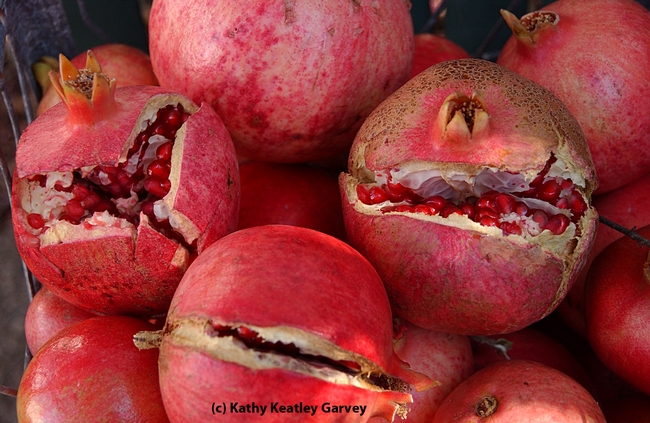
California is the sole producer of 99 percent of the pomegranates grown in the United States. (Photo by Kathy Keatley Garvey)
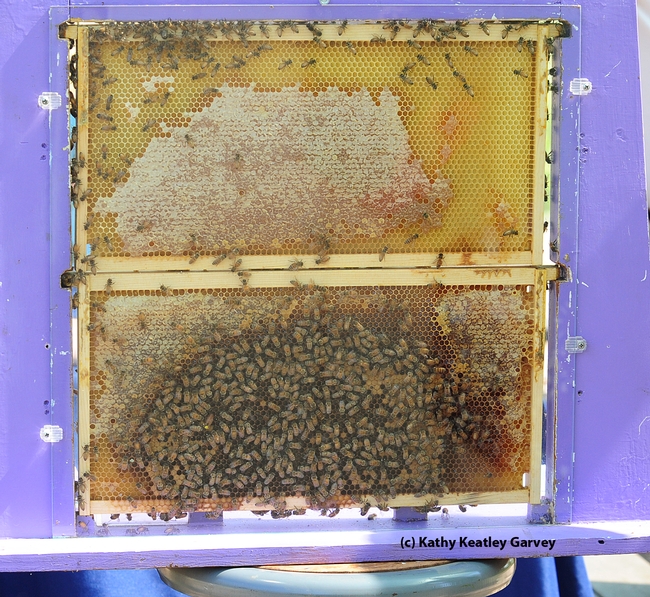
This bee observation hive from the Harry H. Laidlaw Jr. Honey Bee Research Facility was showcased at the Honey and Pollination Center event. (Photo by Kathy Keatley Garvey)
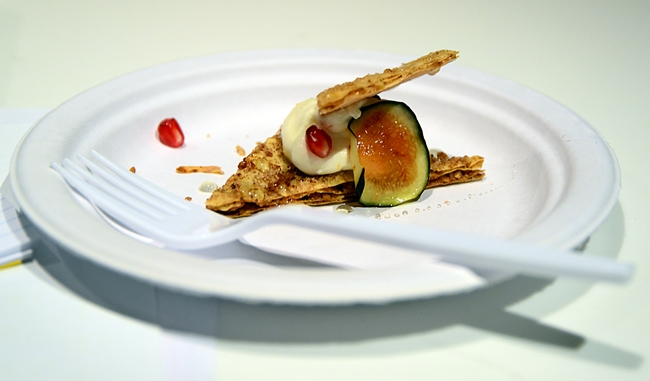
Close-up of Baklava-Inspired Napoleans. (Photo by Kathy Keatley Garvey)
Feijoa - You can eat that?
I first tasted a feijoa (fay-zho-uh, or pineapple guava) as a student here at UC Davis many years ago. A friend showed me her secret trees (south side of Wellman in Davis — tons on the ground right now!), and I was hooked. I didn’t think much of it at the time, other than thinking this is one of the best things I have ever eaten in my life. It tastes better than candy, and ripens right around Halloween - sweet! I had never seen or heard of a feijoa. You likely haven’t either, so I’m writing to introduce you.
First a little history. This subtropical plant originated in the higher altitude regions of central South America, but has since been introduced and grown commercially in Europe, California, New Zealand, South Africa and the area around southern Russia. In California, Sutter and Yuba counties were the hot spot for growing pineapple guavas in the late 1980s. Farmers in that area, who benefitted from the kiwi expansion a few years before, enthusiastically jumped into the feijoa business, however did not realize the same success.
According to Adel Kader, UC Cooperative Extension specialist emeritus, "the nurseries that provided the trees were not accurate in identifying the different variety of trees, and there was a large difference in the taste.”
So a farmer had no idea if he had a good tree or not. Additionally, judging fruit maturity is difficult since the fruits do not significantly change color as they ripen and drop to the ground when they’re mature. So the optimal picking strategy is by “touch picking” where if you touch a fruit and, if it comes off the plant, it’s ready to eat. Imagine doing that for a whole orchard.
Back to the present. I rediscovered feijoas after riding my bike down our street before the green waste pick-up a couple years ago and noticed about 30 feijoas in my neighbor’s pick-up pile! They didn’t know you could eat them. So, yes, I picked them out of the pile and introduced my neighbors to the deliciousness of the pineapple guava. And then I promptly went out and bought myself a tree to plant in my own yard.
Feijoas taste like taking the best elements of strawberry, guava and pineapple and mixing them together. They smell pleasantly sweet and flowery. To eat a feijoa, cut (or rip) it in half and scoop out the inside creamy white flesh (a little brownish color is fine to eat). Feijoas are a good source of vitamin C, fiber and potassium, and they even contain a little protein.
So, where can you find feijoas? Well, if you're in Davis, visit the south side of Wellman. Or, you can plant your own tree like I did (you can reference the Postharvest Technology Center’s Produce Fact Sheet for Feijoas here), or you can go to your local farmers market. It’s a short season, so this is the weekend to search them out. When you find them, Kader suggests you “look for a larger fruit with a slight give and a nice aroma.” You won’t be disappointed.
New reason to give thanks for the sweet potato
What if you could significantly improve the nutritional quality of your diet, just by switching one of the vegetables you eat every day?
In parts of Africa, some people are doing just that by switching from yellow or white sweet potatoes to orange-fleshed varieties.
That orange color signifies the potato’s beta-carotene content, which our bodies convert to vitamin A. Vitamin A deficiency is the leading cause of preventable blindness in children and is crucial to the survival of children and pregnant women, according to the World Health Organization.
So scientists and organizations who are working to increase vitamin A in African diets have turned to the orange-fleshed sweet potatoes as a potential solution, wherever light-colored sweet potatoes loom large.
With funding from the U.S. Agency for International Development, Horticulture CRSP is working in Ghana to strengthen the entire value chain of orange-fleshed sweet potato — from farmers and food processors, to markets and consumers.
Though Horticulture CRSP is led by UC Cooperative Extension’s Elizabeth Mitcham at UC Davis, this project includes a team of international researchers with experts from Tuskegee University, Penn State and Ghana University. Together, they are working to:
- provide farmers with germplasm and best management practices
- teach women entrepreneurs to process orange-fleshed sweet potatoes into bread flour, purees and dehydrated chips
- formulate a weaning food for babies that incorporates orange-fleshed sweet potatoes with other, traditional foods
Find out more about this Horticulture CRSP sweet potato project (including a 2-minute video).
Did you know? In 2011 California was the second largest producer of sweet potatoes in the United States, with North Carolina leading the way (source). Find out more in this related ANR News Blog post or from the UC Vegetable Research and Information Center.
Earning your antioxidants
The pomegranate has moved from a fruit once used primarily as a holiday table decoration to a sought after health food. Rich in antioxidants with a tangy flavor and a deep jewel like color, there's a lot to love about the pomegranate. Except, getting to the fruit. Extracting the edible arils is tricky enough; but take the next step of juicing and you'll quickly realize why commercially prepared pomegranate juice carries a dear price tag.
We have two pomegranate trees in our yard, and this year we have a bumper crop of the seedy beauties. Add to that the grocery bag of pomegranates that usually ends up on our porch from a friend and you've got more arils than most people would care to eat. So last weekend I donned an apron and rubber gloves and set to making juice.
Everyone has their preferred method of extracting the seeds or arils. Most common is scoring the fruit then submerging it in a large bowl of water. Once underwater you can break apart the fruit and separate the seeds from the rind and the pithy membrane. The pith will float to the top of water and the seeds will stay at the bottom of the bowl - making them easy to separate.
The next step is to place the arils in a food mill to separate the seeds from the juice.
Another method, which I only recommend if your final aim is juice rather than arils, is to use an old-fashioned citrus reamer. I happen to have an aging but trusty electric counter top model, so this method is great for me. Simply cut the pomegranates in half and place them on the citrus reamer as you would an orange or grapefruit.
The citrus reamer will separate most of the pith and seeds, releasing part, but not all of the juice. If you're feeling really ambitious, you can put the released seeds and pith through the food mill to extract even more of the juice.
Either method requires a final step of straining the juice through a fine metal strainer. Omit this step and you'll have cloudy juice.
A few hours later, spattered and stained head to toe with pomegranate juice, you'll have your prize -- clear, sparkling, healthy pomegranate juice!



